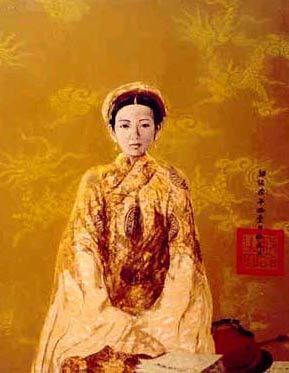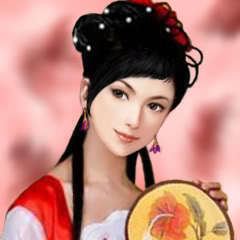Name Huyen Tran Died 1340, Vietnam Grandparents Tran Thanh Tong | Role Tran Nhan Tong\'s daughter Siblings Tran Anh Tong | |
 | ||
Parents Kham Tu Bao Thanh, Tran Nhan Tong Nieces Hue Chan, Thien Chan, Huy Chan, Y Trinh, Thanh Chan Similar People Tran Nhan Tong, Tran Anh Tong, Tran Thanh Tong | ||
Huyen tran princess temple in hue vietnam n huy n tr n c ng ch a
Princess Huyền Trân (Chinese : 玄珍公主, Vietnamese : Huyền Trân công chúa) of Trần Dynasty later Queen Parameswari of Champa, was a princess in the history of Vietnam.
Contents
- Huyen tran princess temple in hue vietnam n huy n tr n c ng ch a
- www tanbinh info pnp 2011 princess 41 b i tr n huy n tr n
- Life
- Huyn Trn in art
- References
www tanbinh info pnp 2011 princess 41 b i tr n huy n tr n
Life

She was the daughter of Emperor Trần Nhân Tông and the younger sister of Emperor Trần Anh Tông. In 1306 Trần Anh Tông married off princess Huyền Trân to the Champa King Jaya Sinhavarman III (Vietnamese: Chế Mân, 制旻) and as Queen Paramecvariin of Champa, in return for the two provinces of Chau O and Chau Ly (or Chau Ri) (today these provinces are Quảng Bình Province, Quảng Trị Province and Thừa Thiên–Huế Province).
There are few details in the historical record about princess Huyền Trân's life. She was born in 1289 but her year of death is unclear. In 1293 Emperor Trần Nhân Tông abdicated in favor of his son, Trần Anh Tông, in order to join a monastery in a pagoda on Mount Yen Tu in what is now Quảng Ninh Province. In 1301, the Emperor's father, Trần Nhân Tông, visited the Champa kingdom and was given a lavish royal welcome by King Jaya Sinhavarman III. The visit lasted nine months. When Trần Nhân Tông left Champa for Đại Việt (the name of Vietnam at the time), he promised to give his daughter in marriage to king Jaya Sinhavarman III even though the Cham king was already married and that Cham queen was a Javanese named Tapasi. Jaya Sinhavarman III thereafter sent many envoys to Đại Việt to urge the Trần King to carry out the marriage plan as Trần Nhân Tông had promised but the Emperor refused. Among the Emperor's men, only General Van Tuc Dao Thai and Minister Trần Khắc Chung supported the marriage. In 1306 Jaya Sinhavarman III offered to cede the two Cham provinces of Chau O and Chau Ly as a dowry and Trần Anh Tông finally agreed to give his sister in marriage to the Cham king. Princess Huyền Trân went to Champa but a year later, in May 1307, Jaya Sinhavarman III died and the crown prince sent an ambassador to Đại Việt to offer white elephants as gifts and announced the death of his king. According to Cham tradition, all of the royal wives would be cremated with the dead king. King Trần Anh Tông ordered a general named Trần Khắc Chung to go to Champa to officially attend the funeral but the real mission was for Trần Khắc Chung to rescue Huyền Trân and take her back to Đại Việt by boat. The trip back took a year. Legends had it that Trần Khắc Chung fell in love with Princess Huyền Trân and the two disappeared from sight together but there is no historical proof to back up this story.
Huyền Trân in art
The sacrifice of princess Huyền Trân (well known in Vietnamese literature and history as "Huyền Trân Công Chúa") has become an attractive topic for poems and arts and music in Vietnamese chữ Nôm. Her marriage is also proverbial.
Most cities in Vietnam have named major streets after her.
